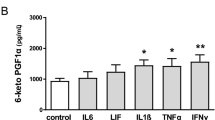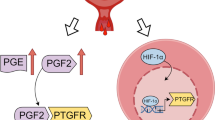Abstract
Objectives
Nitric oxide synthase (NOS), responsible for the synthesis of nitric oxide (NO), is the key enzyme that regulates the NO-mediated biologic functions in various types of tissue. We believed that NO may be involved in regulating the development of the microvascular system and vascular tone in human endometrium. However, the biology of NOS in this system remains poorly understood. To determine the paracrine action of NOS derived from endometrial cells on vascular blood flow, the first task is to identify NOS in endometrial cells. This study was undertaken to examine whether human endometrial cells would express endothelial or inducible NOS (eNOS or iNOS). In addition, we examined the cell-specific expression of eNOS.
Methods
Beta nicotinamide adenine dinucleotide reduced form (NADPH)-diaphorase histochemistry assay was carried out in human endometrial specimens (n = 4). Nitric oxide synthase mRNA expression was studied in intact tissue (n = 4), isolated epithelial glands (n = 25), and stromal cells (n = 10). Northern blot and solution hybridization/ribonudease protection assay with specific RNA probes transcribed from human eNOS and iNOS cDNA were used to identify NOS mRNAs.
Results
NADPH-diaphorase histochemistry selectively labeled epithelial glands in the late secretory phase. Northern blot analysis revealed that glandular cells expressed a single size of eNOS mRNA (4.5 kb) but no detectable iNOS. Endothelial NOS mRNA was expressed in epithelial glands, but it was not detectable in stromal cells. The relative amount of eNOS in epithelial glands isolated from specimens (n = 23) at various stages of menstrual cycle were analyzed using a solution hybridization assay. The levels of eNOS mRNA varied among specimens. Epithelial glands from early secretory endometrium showed greater expression of eNOS mRNA. The highest eNOS expression was found in the glands of late secretory endometrium. In contrast, iNOS was detected only in the epithelial glands of a menstrual endometrium.
Conclusion
This study demonstrated that NADPH-diaphorase activity is highly concentrated in the epithelial glands if late secretory endometrium. Expression of eNOS mRNA is enhanced in the glands of early secretory endometrium. The strongest expression resides in the epithelial glands of late secretory endometrium. This observation suggests that regulation of eNOS may be a physiologic response to steroid hormones and locally produced peptide hormones in the endometrial environment. It also suggests that NO may play a role in the onset of menses.
Similar content being viewed by others
References
Moncada S, Palmer RM, Highs EA. Nitric oxide—Physiology’, pathophysiology and pharmacology. Pharmacol Rev 1991;43: 109–42.
Nathan C, Xie Q. Regulation of biosynthesis of nitric oxide. J Biol Chem 1994;269:13725–8.
Forstermann U, Nakanet M, Tracey WR, Pollack JS. Isoforms of nitric oxide synthase: Functions in the cardiovascular system. Eur Heart J 1993;14 (supplement I):10–15.
Mani SK, Allen JM, Retton V, McCann SM, O’Mally BW, Clark JH. Nitric oxide mediates sexual behavior in female rats. Proc Natl Acad Sci U S A 1994;91:6468–72.
Weiner CP, Ignacio L, Baylis SA, Knowles RG, Charles IG, Moncada S. Induction of calcium-dependant nitric oxide synthase by sex hormones. Proc Nad Acad Sci U S A 1994;91:5212–6.
Yallampalli C, Byam-Smith M, Nelson SO, Garfield RE. Steroid hormones modulate the production of NO and cGMP in rat uterus. Endocrinology 1994;134:1971–4.
Marumo T, Nakaki T, Adachi H, Esumi H, Suzuki H, Saruta T, Kato R. Nitric oxide synthase in endothelial cells: Synergistic induction by INF-gamma, TNFa and lipopolysaccharide and inhibition by dexamethasone. Jpn J Pharmacol 1993;63:327–34.
Chaudhun G, Nathan L. Nitric oxide and endometrial blood flow in steroid hormones and uterine bleeding. Alexander N, D’arcangues C, eds. AAAS publication 1992;22:241–4.
Franchi AM, Chaud M, Retton V, Suburo A, McCann SM, Gimeno M. Role of NO in ecosanoid synthesis and uterine motility in estrogen-treated rat uteri. Pro Nat Acad Sci U S A 1994;91:539–43.
Yallampalli C, Izumi H, Byam-Smith M, Garfield RE. An L-arginine-nitric oxide-cyclic guanosine monophosphate system exists in the uterus and inhibits contractility during pregnancy. Am J Obstet Gynecol 1993;170:175–185.
Van Buren GA, Yang D, Clark KE. Estrogen-induced uterine vasodilatation is antagonized by L-nitro argimne methyl ester, an inhibitor of nitric oxide synthesis. Am J Obstet Gynecol 1992; 167:828–33.
Goligorsky MS, Tsukahara H, Magazine H, Andersen TT, Malik AB, Bahou WF. Termination of endothelin signaling: Role of nitric oxide. J Cell Physiol 1994;158:485–94.
Tsukahara H, Ends H, Magazine HI, Bahou W, Goligorsky MS. Molecular and tunctional characterization of non-isopeptide-selective ETb receptor in endothelial cells, receptor coupling to NOS. J Biol Chem 1994;269:21778–85.
Corbett JA, Kwon G, Turk J, McDaniel ML. IL-1 beta induces the co-expression of both nitric oxide synthase and cyclooxy-genase by islets of Langerhans: Activation of cyclooxygenase by nitric oxide. Biochemistry 1993;32:13767–70.
Tseng, Liu HC. Stimulation of estrogen sulfurylation and arysul-fotransferase activity in human endometrium by progestin in vitro. J Clin Endocrinol Metab 1981;53:418–21.
Zhu HH, Huang JR, Mazella J, Rosenberg M, Tseng L. Differential effects of progestin and relaxin on the synthesis and secretion of immunoreactive prolactin in human endometrial stromal cells. J Clin Endocrinol Metab 1990;71:889–99.
Jaffe EA, Nachman R, Becker C, and Minick C. Culture of human endothelial cells derived from umbilical veins. Identification of morphologic and immunologic criteria. J Clin Invest 1973;52:2745–56.
Hope BT, Michael GJ, Knigge KM, Vincent SR. Neuronal NADPH diaphorase is a nitric oxide synthase. Proc Natl Acad Sci USA 1991;88:2811–4.
Tseng L, Gao JG, Chen R, Zhu HH, Mazella J, Powell DR. EfTect of progestin, antiprogestin, relaxin on the accumulation of PRL and IGFBP-I mRNA in human endometrial stromal cell. Biol Reprod 1992;47:441–50.
Janssens SP, Shimoushi A, Quetermous T, Bloch DB, Bloch KD. Cloning and expression of a cDNA encoding human endothe-lium-denved relaxing factors/NOS. J Biol Chem 1992;267: 14519–22.
Geller Da, Lowenstein CJ, Shapiro RA, Nussler AK, Snyder SH, Billar TR. Molecular cloning expression of inducible NOS from human hepatocytes. Proc Natl Acad Sci U S A 1993;90:3491–5.
Rierer RK, Musci TJ, Bansal RK, Ecker JL, Natuzzi ES. Pregnancy induces NOS in the uterus. 42nd Annual Meeting of Society of Gynecologic Investigation. Abstract no. 76, 1995.
AH M, Yallampalli C, Chealisz K, Garfield RE. Changes in mRNA NOS in rat uterus and cervix during pregnancy. 42nd Annual Meeting of the Society of Gynecologic Investigation. Abstract no. 80, 1995.
Cameron IT, Plumpcon C, Champeney R, van Papendorp C, Ashby MJ, Davenport AP. Identification of endothelin-1, -2 and -3 in human endometrium. J Repro Fertil 1993;97:251–5.
Casey ML, Macdonald PC. Regulation of endothelin-1 and biosynthesis and degradation human endometrium HEC-1A cancer cells. Alexander N, D’arcangues C, eds. AAAS publication 1992; 22:209–24.
Author information
Authors and Affiliations
Additional information
The investigation received financial support from the Special Programme of Research Development and Research Training in Human Reproduction, World Health Organization, no. 90116, and National Institutes of Health, USPHS grant HD-19247 to LT.
We thank the clinical staffs of the Departments of Obstetrics and Gynecology and Pathology at the State University of New York at Stony Brook, New York, and the physicians and pathologists at St. Charles Hospital, Port Jefferson, New York, for providing us with viable endometrial specimens and histologic diagnosis: Dr. Bloch and Dr Geller for providing eNOS and iNOS cDNA; Mr. J. Mazella for isolating and culturing endometrial cells; and Ms. Angela Sintchak for editing the manuscript.
Rights and permissions
About this article
Cite this article
Tseng, L., Zhang, J., Peresleni, T.Y. et al. Cyclic Expression of Endothelial Nitric Oxide Synthase mRNA in the Epithelial Glands of Human Endometrium. Reprod. Sci. 3, 33–38 (1996). https://doi.org/10.1016/1071-5576(95)00039-9
Published:
Issue Date:
DOI: https://doi.org/10.1016/1071-5576(95)00039-9




